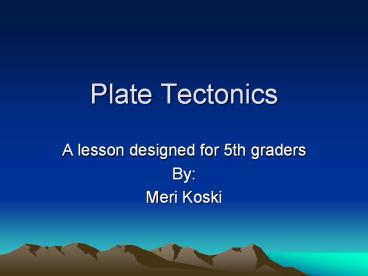Plate Tectonics - PowerPoint PPT Presentation
1 / 11
Title:
Plate Tectonics
Description:
Plate Tectonics A lesson designed for 5th graders By: Meri Koski Where two plates meet, it is called a boundary. There are three different types of boundaries that ... – PowerPoint PPT presentation
Number of Views:56
Avg rating:3.0/5.0
Title: Plate Tectonics
1
Plate Tectonics
- A lesson designed for 5th graders
- By
- Meri Koski
2
- The theory of plate tectonics is only about 30
years old. It states that the outer layer of
Earth (the lithosphere) is broken into 7 plates
that move in all different directions and at
varying speeds (2-10cm per year). - The movement of these plates explains to us
natural disasters such as volcanoes and
earthquakes, worldwide distribution of plant and
animal fossils, and the movement of the mantle
(the layer below Earths crust).
3
- Where two plates meet, it is called a boundary.
There are three different types of boundaries
that describe how the plates are moving. - Convergent Boundaries plates collide
- Divergent Boundaries plates move apart
- Transform Boundaries plates move against each
other
4
Convergent Boundaries
- Plates crash together.
- Continental plate is pushed up and forms
mountains. - Oceanic plate sinks below continental plate and
becomes part of the mantle. - Earthquakes occur due to the collision of plates.
- Melting oceanic plate and mantle rise up into the
mountain creating a volcano - The Himalayan and Appalachian mountains are
results of plates colliding.
5
Divergent Boundaries
- Plates are drifting apart.
- A rift valley forms, which is a deep crack in the
crust. - As plates move apart, magma comes up and forms a
new crust. - The Mid-Atlantic ridge (the largest mountain
range) was formed this way and is still growing.
6
Transform Boundaries
- Plates slip slide
- The San Andreas Fault is one of the most famous
transform boundaries - No mountains or spectacular features form along
this boundary. - Tension builds between two plates and releases.
- An earthquake is usually the result of these
plates moving.
7
Our Earth then and now
- About 200 million years ago the land masses on
Earth were fused together. This single continent
is known as Pangaea. - Due to the movement of the mantle (under the
crust), Pangaea has formed into the Earth we know
today.
8
Evidence that Pangaea did exist
- Fossils are the main form of evidence that our
continents were once fused. - Similarities between plant and animal fossils
have been found on land masses that are very far
apart today (such as Africa and S. America). - For example dinosaur fossils and footprints have
been found in many places around the world. If
the land masses were separated like they are now,
how did they get across the oceans?
9
- This picture illustrates different dinosaurs and
plants that have been found all over the world. - This was possible because of Pangaea!
10
Web sites to learn more!
- Check out these web sites to learn more about
plate tectonics. - Interactive Plate Tectonic Site
- Plate Tectonics
11
Test your knowledge
- Now that you have learned about the theory of
plate tectonics, you can test what you know! - Plate Tectonic Quiz 10 question, multiple
choice quiz on PowerPoint. - Answers To Quiz Check how much you really
know.































